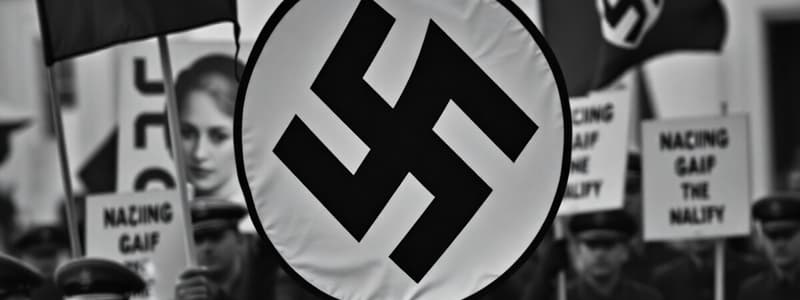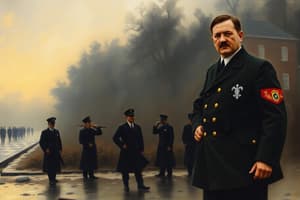Podcast
Questions and Answers
What were the girls in the Bund Deutscher Mädel (BDM) primarily prepared for?
What were the girls in the Bund Deutscher Mädel (BDM) primarily prepared for?
- Military service
- Role as mothers and housewives (correct)
- Leadership in the Hitlerjugend
- Participation in sports competitions
The Edelweißpiraten supported the Hitlerjugend and embraced their ideology.
The Edelweißpiraten supported the Hitlerjugend and embraced their ideology.
False (B)
What type of music did the Swing-Kids prefer?
What type of music did the Swing-Kids prefer?
Jazz
Zivilcourage means being brave to stand up for ________, even when it is dangerous.
Zivilcourage means being brave to stand up for ________, even when it is dangerous.
Match the following groups or individuals with their actions during the Nazi era:
Match the following groups or individuals with their actions during the Nazi era:
What was one of the primary goals of the NSDAP?
What was one of the primary goals of the NSDAP?
The NSDAP supported the Treaty of Versailles.
The NSDAP supported the Treaty of Versailles.
What title did Hitler use to signify his absolute control over Germany?
What title did Hitler use to signify his absolute control over Germany?
The NSDAP's program that outlined their goals was known as the _____ program.
The NSDAP's program that outlined their goals was known as the _____ program.
Match the following terms with their definitions:
Match the following terms with their definitions:
What was one reason for the NSDAP's push for more land?
What was one reason for the NSDAP's push for more land?
Antisemitism was a core belief upheld by the NSDAP.
Antisemitism was a core belief upheld by the NSDAP.
When was Hitler appointed Chancellor of Germany?
When was Hitler appointed Chancellor of Germany?
What was one of the main tasks of the SA (Sturmabteilung)?
What was one of the main tasks of the SA (Sturmabteilung)?
The SS (Schutzstaffel) was responsible for organizing state ceremonies.
The SS (Schutzstaffel) was responsible for organizing state ceremonies.
What was the primary goal of the Gestapo?
What was the primary goal of the Gestapo?
The ________ was responsible for military expansion across Europe under National Socialist leadership.
The ________ was responsible for military expansion across Europe under National Socialist leadership.
Match the organization with its main focus:
Match the organization with its main focus:
Which of the following was NOT a function of the Hitler Youth?
Which of the following was NOT a function of the Hitler Youth?
The NSDAP used propaganda to support its agenda and intimidate opponents.
The NSDAP used propaganda to support its agenda and intimidate opponents.
What event did the Nazis use as a pretext to persecute political opponents in 1933?
What event did the Nazis use as a pretext to persecute political opponents in 1933?
Name one medium used by the NSDAP to spread its propaganda.
Name one medium used by the NSDAP to spread its propaganda.
The Reichstagsbrandverordnung abolished every right in the constitution.
The Reichstagsbrandverordnung abolished every right in the constitution.
The film ________ (1935) illustrated the power and unity of the NSDAP.
The film ________ (1935) illustrated the power and unity of the NSDAP.
What did the Ermächtigungsgesetz allow Hitler to do?
What did the Ermächtigungsgesetz allow Hitler to do?
The Nazi party became the only authorized party after the passage of the Law Against the ______ of Parties.
The Nazi party became the only authorized party after the passage of the Law Against the ______ of Parties.
What was one of the goals of the Hitler Youth?
What was one of the goals of the Hitler Youth?
Match the following events with their descriptions:
Match the following events with their descriptions:
What was a major consequence of Gleichschaltung in April 1933?
What was a major consequence of Gleichschaltung in April 1933?
After President Hindenburg's death, Hitler held both the positions of Fuhrer and Chancellor.
After President Hindenburg's death, Hitler held both the positions of Fuhrer and Chancellor.
What method did the Nazis use to suppress dissenting opinions?
What method did the Nazis use to suppress dissenting opinions?
The Nazis replaced trade unions with the ______ as part of their consolidation of power.
The Nazis replaced trade unions with the ______ as part of their consolidation of power.
Which event symbolized the collaboration between the old elite and the Nazis?
Which event symbolized the collaboration between the old elite and the Nazis?
Flashcards
What was the purpose of the Hitler Youth?
What was the purpose of the Hitler Youth?
The Hitler Youth was a youth organization in Nazi Germany that aimed to indoctrinate young people with Nazi ideology and prepare them for military service. They were involved in activities like sports, camping, and military drills.
What was the BDM and what did it aim to achieve?
What was the BDM and what did it aim to achieve?
The Bund Deutscher Mädel (BDM) was a Nazi girls' organization that aimed to prepare girls for their roles as obedient wives and mothers who would uphold Nazi values. They participated in activities like sports, household skills, motherhood training, and Nazi propaganda.
Who were the Swing Kids and what made them different?
Who were the Swing Kids and what made them different?
Swing Kids were a group of German teenagers in the 1930s who defied Nazi rules by listening to Jazz music, dancing, and wearing unconventional clothing. Their rebellious attitude and non-conformity to Nazi ideals made them a target for the regime.
Who were the Edelweiss Pirates and what did they do?
Who were the Edelweiss Pirates and what did they do?
Signup and view all the flashcards
What is Zivilcourage and what are some examples of it during the Nazi era?
What is Zivilcourage and what are some examples of it during the Nazi era?
Signup and view all the flashcards
Dictatorship
Dictatorship
Signup and view all the flashcards
Gleichschaltung - Coordination
Gleichschaltung - Coordination
Signup and view all the flashcards
Führer - Leader
Führer - Leader
Signup and view all the flashcards
Concentration Camp
Concentration Camp
Signup and view all the flashcards
Propaganda
Propaganda
Signup and view all the flashcards
Racism
Racism
Signup and view all the flashcards
Gestapo
Gestapo
Signup and view all the flashcards
Antisemitism
Antisemitism
Signup and view all the flashcards
SA (Sturmabteilung)
SA (Sturmabteilung)
Signup and view all the flashcards
SS (Schutzstaffel)
SS (Schutzstaffel)
Signup and view all the flashcards
Gestapo (Geheime Staatspolizei)
Gestapo (Geheime Staatspolizei)
Signup and view all the flashcards
Wehrmacht
Wehrmacht
Signup and view all the flashcards
Propaganda in Nazi Germany
Propaganda in Nazi Germany
Signup and view all the flashcards
Triumph des Willens
Triumph des Willens
Signup and view all the flashcards
Volksempfänger
Volksempfänger
Signup and view all the flashcards
Hitler Youth (HJ)
Hitler Youth (HJ)
Signup and view all the flashcards
Nazi organizations and Control
Nazi organizations and Control
Signup and view all the flashcards
Propaganda and Control
Propaganda and Control
Signup and view all the flashcards
Reichstag Fire (February 27, 1933)
Reichstag Fire (February 27, 1933)
Signup and view all the flashcards
Reichstag Fire Decree (February 28, 1933)
Reichstag Fire Decree (February 28, 1933)
Signup and view all the flashcards
Enabling Act (March 23, 1933)
Enabling Act (March 23, 1933)
Signup and view all the flashcards
Dissolution of Trade Unions (May 2, 1933)
Dissolution of Trade Unions (May 2, 1933)
Signup and view all the flashcards
Gleichschaltung (April 1933)
Gleichschaltung (April 1933)
Signup and view all the flashcards
Law Against the Formation of New Parties (July 14, 1933)
Law Against the Formation of New Parties (July 14, 1933)
Signup and view all the flashcards
Handshake on "Potsdam Day" (March 21, 1933)
Handshake on "Potsdam Day" (March 21, 1933)
Signup and view all the flashcards
Gestapo and Terror
Gestapo and Terror
Signup and view all the flashcards
Propaganda and Censorship
Propaganda and Censorship
Signup and view all the flashcards
Hitler's Sole Rule
Hitler's Sole Rule
Signup and view all the flashcards
Study Notes
NSDAP Goals
- The National Socialist German Workers' Party (NSDAP) aimed to radically transform Germany and society according to their ideology.
- They sought complete control over all aspects of life.
- Their 25-point program outlined key objectives.
Key NSDAP Goals
- German Community: The NSDAP envisioned a racially homogenous community, prioritizing those deemed "German."
- Leadership of a Dictator: They advocated abolishing democracy, with Adolf Hitler as the sole leader.
- Expansion of German Territory: The party planned to conquer eastern territories to create "living space" for Germans.
- Persecution and Exclusion: The NSDAP targeted and persecuted those deemed "different" by their ideology, including Jews.
- Rejection of Treaty of Versailles: The party opposed the Treaty of Versailles, aiming to strengthen German power.
Important Concepts
- Dictatorship: A system of government where a single person or small group holds absolute power without input from the people.
- Gleichschaltung: The process of imposing Nazi control over all aspects of German life.
- Führer (Leader): The title Hitler used to assert his absolute authority over Germany.
- Concentration Camps: Sites of imprisonment, forced labor, and often murder for those deemed enemies of the Nazi state.
Propaganda
- Propaganda was used to shape public opinion and promote Nazi ideas.
- The Nazis used numerous methods, including rallies, posters, and films.
- Propaganda aimed to manipulate and influence the population.
Timeline of Nazi Consolidation
- January 30, 1933: Hitler appointed Chancellor of Germany.
- February 27, 1933: The Reichstag fire, a crucial event used to justify further repression.
- This led to the passing of the enabling act, which gave Hitler sweeping powers.
- March 23, 1933: Enabling Act granted Hitler dictatorial powers.
- May 2, 1933: Dissolution of trade unions, replacing them with the German Labor Front.
- April 1933: The Nazi party began to control all aspects of German life through various measures aimed at controlling media, education, and other avenues of societal influence.
- July 14, 1933: Prohibition of parties besides the Nazi Party.
Nazi Organizations
- SA (Storm Troopers): Involved in street violence and intimidation against political opponents.
- SS (Schutzstaffel): Responsible for security, intelligence, and carrying out the most brutal aspects of Nazi policies. Also involved in maintaining order and running concentration camps.
- Gestapo (Secret State Police): Used surveillance, arrests, and torture.
- Wehrmacht: The armed forces, used for conquest.
Youth Organizations
- Hitler Youth: Organization for boys.
- League of German Girls: Similar organization for girls.
- Both groups were used to inculcate Nazi ideology in youth, preparing them to accept and support the party.
Opposition and Resistance
- Despite the Nazi's control, there were individuals who resisted or practiced civil disobedience.
- Examples of both individual and collective actions are detailed.
Studying That Suits You
Use AI to generate personalized quizzes and flashcards to suit your learning preferences.




